We test the Cannondale Scalpel HT, the first new generation hardtail
Just a few days ago we brought you the presentation of the new Cannondale Scalpel HT, in which we unveiled its most important features and innovations. Now after several hundred kms on the Cannondale Scalpel HT Hi-Mod 1 we bring you a more detailed analysis and all the sensations that it has transmitted us.

Goodbye F-Si, hello Scalpel HT
The changes in XCO circuits, increasingly technical and with steep descents, are leading brands to redesign their competition models. This is what has happened with the Cannondale Scalpel HT. The idea is simple: to make the fastest bike, capable of climbing with explosive accelerations and to handle any downhill, however complicated it may be, with total ease.
To achieve the greatest lightness without losing an ounce of stiffness, they have opted, as expected, for the best carbon available from the brand, the BallisTec Hi-MOD. This was not the main objective, however, the new design has also reduced its weight to 895 g without accessories (980 g with all the accessories), something that the most demanding bikers tend to take into account.
RECOMENDADO

Brujulabike wishes you a Merry Christmas

25 cycling gifts ideas to get it right

Do you need a power meter to become a better cyclist?

Our 7 favourite XC hardtails of 2022

MTB XCO European Championships 2022: favorites, schedule and where to watch it live online

Snowshoe XCO World Cup 2022: favorites, schedules and how to watch it
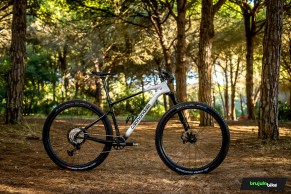
It follows stylised lines becoming only more muscular in the area of the steering head pipe.
At first glance there are two notable changes, the more swept steering angle to make it more capable on descents and the rear triangle with low stays, something that departs from the usual aesthetics followed until now by its predecessor, the F-Si. The latter change is due to the pursuit of two generally opposing traits, flexibility and stiffness. Lowering the stays results in a more compact rear triangle, making it more torsionally rigid. A measure inherited from its road model, the SuperSix Evo.
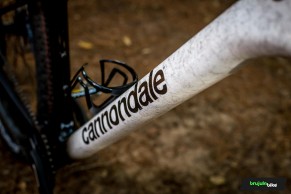
On the other hand, having this stiffness can have a negative impact on the transmission of imperfections in the terrain to the rider. To achieve this, carbon flex is used in specific areas of the frame. It is already customary to see in their models the SAVE technology, a microsuspension obtained by bending the carbon itself. In this case they have gone a step further, and have sought a greater vertical flex in the area where the chainstays and stays meet the rear wheel axle. With this they have achieved a Flex-Zone similar to the Flex-Pivot of the Scapel, its full suspension sister. In addition, the 27.2 mm seatpost has been used for the best possible comfort on a hardtail bike.
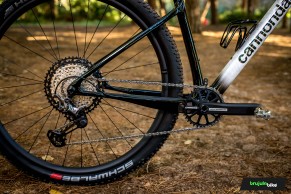
The bottom bracket remains the same, an 83mm Press Fit 30. If something works, why change it.
One thing we don't find on the Scalpel HT is the offset Ai drivetrain. Instead we find a new standard 55mm chainline which is very similar to that achieved with the Ai concept. With this Cannondale has gained the benefits of a wider wheel arch and stronger wheel construction, as well as opening up the range of compatibility with other brands' components. Something that is sure to be well received by users and at the same time demonstrates how their ideas are influencing the cycling industry.

One detail that surprised us was the return to the traditional seat post clamp. In the F-Si version this was integrated into the down tube, giving a very clean look in that area. However, on this occasion they have opted for the traditional one in order to achieve simplicity and lightness.
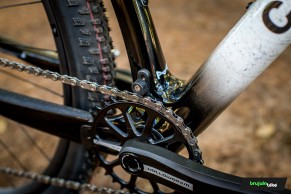
What is maintained in this frame is the Speed Release axle system on the rear wheel, which allows us to remove it without having to remove the axle completely, something that for XCO competitions can save us a few seconds in case we have to change a wheel. This system is combined with the use of the UDH hanger that favours the compatibility of the components. A minimalist chain guide ensures that the chain always stays in place.
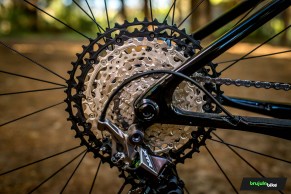
Another new feature is the internal cable routing system. The entry holes are located in the steering head pipe and it offers as a novelty the possibility of mounting with a complete sheath from beginning to end, or only placing a sheath on the outer parts. In the first case we will have the security that the cable will always work correctly, as it is protected from any external agent, on the other hand if the assembly is done only covering the external parts we will save about 50 grams.

The only thing missing from this new frame is a steering lock. It can prevent critical bumps of the peripherals with the horizontal tube. An addition that would be welcomed by the vast majority of users.
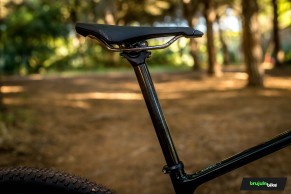
New Lefty Ocho 110 mm
Within the Scalpel HT range, Hi-Mod 1 is the only version we can find mounted with the Lefty Ocho 110 mm fork. This is the model that maintains the same structure as the 120 mm modified to offer those 110 mm of travel (it can be adjusted to take it up to 120 mm).
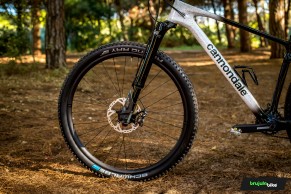
Cannondale has introduced this frame as the first hardtail designed for forks with more than 100mm of travel.
This extra 10 mm will relax your steering angle by 0.5°. As well as benefiting from the increased absorption and sensitivity of the Lefty Ocho 120 version.
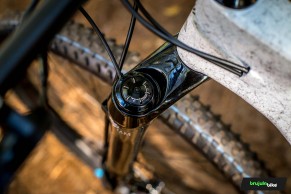
With more travel and a more relaxed steering angle, you have to play with the fork offset to achieve similar reactions to the 100mm Lefty Ocho. That's why the Lefty Ocho 120 has an offset of 50 mm.

Geometry adapted to new requirements
Without a doubt, the most important changes are in its geometry. This is where work has been done to give the Scalpel HT the necessary characteristics to go faster on all terrains.
It leaves behind the racing geometry of the F-Si to move to values more similar to trail bikes, a renovation focused on conquering any XCO circuit.
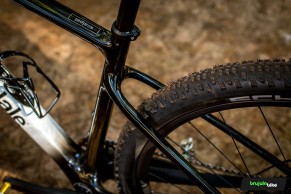
The model we tested is the only one with a 110 mm fork, which modifies its geometry a little more. For starters, its steering angle is 66.5º, a far cry from the 69º declared by the F-Si (67º on the Scalpel HT models with 100 mm forks). With this, the Scalpel HT gets a stability and security downhill that some might miss in the F-Si, although those 69 °, at that time, already represented a progressive value within the segment.

The seat tube angle is 74.5°, slightly more vertical than its predecessor. The aim is to increase pedalling efficiency to compensate for the relaxed steering and thus maintain, as far as possible, its climbing properties. The reach remains at 423 mm, only 3 mm higher than that of the F-Si.
One of the most innovative features is the chainstay length. Applying the Proportional Response philosophy, chainstays have been designed in different lengths depending on the frame size. They range from 430 mm to 445 mm. This ensures that the rider's weight remains as centered as possible to obtain unimaginable traction and handling values.
Lightweight and quality assembly
The Hi-Mod 1 is predominantly built using the reliable and well-proven Shimano XT groupset with the addition of the XTR rear derailleur. The only difference compared to the F-Si is that it also uses the XTR shifter. It is equipped with a 10-51 cassette and a 34T chainring, a development more than enough to face any situation.
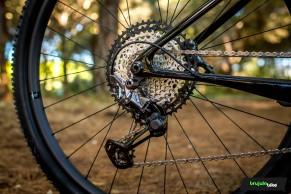
With the brakes, you go from using XTR brakes to XT brakes. There is a difference between them in the feel and the progressiveness of the braking. Apart from the weight difference, there are probably bikers who prefer to have the XTs as standard. On the front wheel a 180 mm disc is used, perhaps excessive for XCO use, but it can be very useful for the long descents that can be found in an XCM.
For the cranks, the choice is still in favour of the aluminium HollowGram cranks that were introduced with the launch of the Scalpel in 2020.

For the wheels they rely on HollowGram 25 carbon rims with an internal width of 25 mm, mounted on HollowGram hubs with DT-Swiss ratchet system. On them we find Schwalbe Racing Ray tyres at the front and Racing Ralph at the rear, both in 2.25" size. On the front hub we find the Cannondale wheel sensor, developed in collaboration with Garmin, which allows us to store information about our routes, as well as to control the periodicity of the revisions... once we link it with the Cannondale app on our smartphone.

The rest of the components, with the exception of the Prologo Dimension NDR saddle, are also from the American firm. The 27.2mm carbon seatpost, 760mm flat carbon handlebar and aluminium stem are all from Cannondale. Even for this Scalpel HT, Cannondale's own grips are used, leaving the EsiGrip grips behind.
In action with the Cannondale Scalpel HT
As soon as we received the bike we could see that it comes in the box fully assembled, we just have to take it out and adjust our measurements to start enjoying it, a detail for the less "handyman" of the mechanics. The paint finish used on the Hi-Mod 1 version with splash effect on the white background, is the same design used on the Cannondale Factory Team bikes in the XCO World Cup. It is also available in a full black colour.
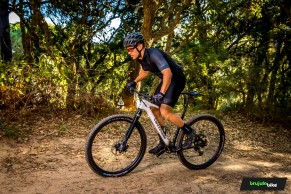
Before heading out for a ride, as usual, we put the Scalpel HT on our scales. It stops at 9.950 kg with pedals, bottle cage and tubeless fluid, ready to go, a weight that may be a little far from some hardtails we find on the market. When we got on the bike we expected to find an aggressive position due to the fact that it is a competition hardtail, however, the position is very centered on the bike without overloading the hands, this is partly because the seat tube is more vertical, they have shortened the stem and have only lengthened the reach 3 mm, following their concept of OutFront geometry.

We went directly to our test track to test it in all possible scenarios. On climbs we can differentiate between two situations, short climbs and long climbs. On short climbs you might think that the weight would be a determining factor, but what we noticed is a dynamic lightness. Every pedal stroke is transferred to the rear wheel really well, the bike/biker weight distribution achieved by the Proportional Response makes it easy to move when standing up and the bike feels lighter than our scales indicated. The centered position makes for a comfortable pedalling action.

Whether pushing hard while seated or standing on the pedals. The bike always moves smoothly and steadily, accelerates very well and progressively. Without ever losing traction at the rear.
On technical climbs it is easy to get over any obstacle. The open steering angle is hardly noticeable on such climbs, it remains well balanced and close to the ground, with no need to position your body over the front at all. It's only in very twisty areas that you notice that it's a little less agile than the F-Si.
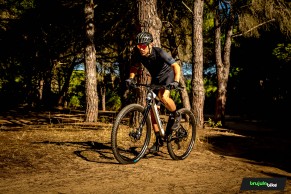
On long, steep climbs, the weight does penalise a bit, but this is compensated for by the comfortable seating position on the bike. Being well positioned on the saddle, without forced postures, allows us to focus on pedalling more effectively.
On downhill, the difference with its predecessor, the F-Si, is perhaps most noticeable. Having a steering angle of 66.5º and the Lefty Ocho with 110mm of travel makes the whole experience a little easier. It's much more stable and sure-footed, letting us get off the bike in a much more relaxed way.
In technical areas it is controllable and precise, moving easily through rocks and roots. The front end is now more stable without losing support when changing direction, allowing us to steer the bike in the direction we want it to go at all times.
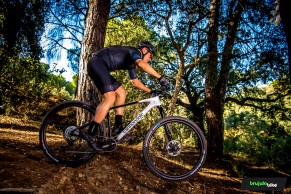
In fast downhill areas the Proportional Response geometry comes into play again, giving us confidence in this situation, as the centred position and the balanced weight distribution gives us stability and allows us to move it perfectly.
Much of the Cannondale Scalpel HT's character is due to the 110mm Lefty Ocho fork. This hardtail is designed to maximise downhill control, and having this 110mm suspension gives it that extra edge.
It takes a lot of sensitivity to feel the difference in travel between the 100 and 110 mm, but you do feel more control of the front end in corners and more precision in copying the terrain in broken areas. All of this helps us to get cleaner and safer routes.
Braking is powerful, the Shimano XT brakes are good value for money and are reliable and powerful in all situations, even on long descents. They don't get spongy. A 180mm disc on the front ensures braking power on long descents, but as we said, for XCO racing it's too big a size. A 160 mm would be sufficient, and would also save a few grams in the final weight.
Looking at the characteristics and geometry of the Cannondale Scalpel HT you might think that it is not a pure racing bike, but beyond that we can say that it has been redesigned to cope with the new demands of the circuits.
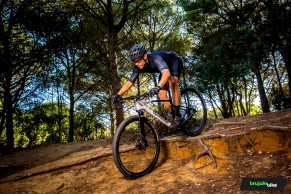
It feels more reactive than expected. The 74.5° seat tube really allows for an excellent pushing position, you can have effective pedalling with less effort.
One option would be to use tyres with more balloon, perhaps 2.35", which would provide even more comfort on both wheels when tackling rocks and roots.
On the other hand, there is a feature that is not perceived at the time, but it is after a long day of pedalling where the benefits of the flex zones, slim chainstays and seat stays, as well as a 27.2 mm seatpost, all together allow filtering the vibrations transmitted by the terrain and that means that we have been able to endure several hours of pedalling without any discomfort.
Conclusion
Without a doubt the new Cannondale Scalpel HT is a statement of intentions on the part of the brand, a modern hardtail oriented to the new XCO. Capable of offering a good climbing performance and a lot of security downhill. Equipped with a fail-safe assembly and an aesthetic that leaves no one indifferent.
The Cannondale Scalpel HT Hi Mod 1 we tested is priced at €6,999, but the range starts from €2,499 and you can see all the models and set-ups here.